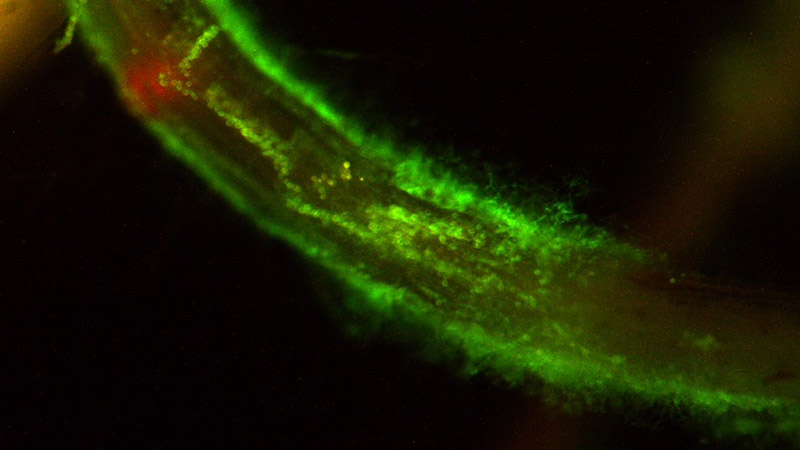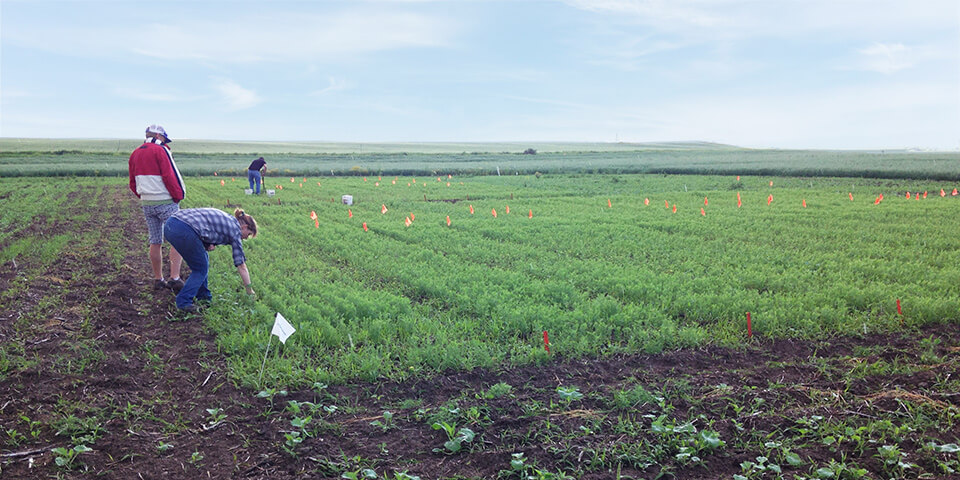Increase Yield and Quality of Canola Crops and Their Seed Oil Content Naturally
With 40 years of experience in biotechnological innovation, and after several years of research, Premier Tech, under its AGTIV® brand, becomes the first manufacturer of biological active ingredients in North America to commercialize Serendipita indica - PTB299 with AGTIV® IGNITE™.
This beneficial natural fungus activates some of the plant's natural mechanisms, helping it to better uptake nutrients, cope with drought, and improve its photosynthetic process thereby optimizing canola crop yields.
Continue reading to learn more about Serendipita and its many benefits to agriculture!
What is Serendipita indica?
Formerly known as Piriformospora indica, Serendipita indica is a beneficial endophytic fungus with the ability to colonize the roots of a wide range of plant species, including the Brassicaceae family (e.g. canola and mustard). When applied to seeds or directly to the soil, the spores germinate within a few days and rapidly colonize the surface of nearby roots. The hyphae of the fungus penetrate the superficial cell layer of the root (epidermis), where they activate a whole series of mechanisms in the plant.
The biostimulant effects of Serendipita have direct and indirect impacts on the plant. The direct effects are mainly related to better assimilation of nutrients; while the indirect effects, which are numerous, influence the transcription of specific plant genes. Thanks to the contribution of Serendipita, the plant becomes more efficient in performing certain functions such as nutrient absorption, water management, and photosynthesis.

In this photo, the fluorescence reveals the colonization of the root's surface and epidermis by Serendipita hyphae.
Benefits for the plant
Improved absorption of essential nutrients
- Sulfur: Sulfur is essential for protein synthesis, a sulfur deficiency considerably reduces nitrogen efficiency and limits protein synthesis. Serendipita has high-affinity transporters for sulfur, allowing it to absorb sulfur from the soil1 very efficiently, which will then be transferred to the plant, in exchange for sugar.
- Phosphorus: Phosphorus, essential for energy storage and availability to cells, is also transferred directly from the fungus to the plant. On the root side, phosphate transporters are membrane proteins that allow phosphorus to enter the plant cell. Colonization by Serendipita stimulates higher production of these transporters by the plant, making it more efficient at absorbing phosphorus from the soil2.
- Nitrogen: Nitrogen is a key element in the plant nutrition process and is involved in protein and chlorophyll synthesis. Colonization3 causes a higher transcription of the plant enzyme nitrate reductase. This enzyme improves the efficiency of nitrogen nutrition by the plant by promoting a more rapid conversion of nitrate to ammonia, the form of nitrogen that plants use for amino acid synthesis.
- Iron: Iron plays an important role in several fundamental biological processes such as photosynthesis, respiration, nitrogen fixation and assimilation, and DNA synthesis. In iron deficiency situations, Serendipita indica has been shown to increase its transcription of an iron transporter, allowing for better availability of iron for the plant4.
Improvement of water management by the plant
- The plant will produce more proline in its root cells5 . This proline will help maintain the upward movement of water in the plant, thereby keeping the stomata open. The plant can therefore continue to take up water even if there is less water or higher soil salinity.
- In parallel, the presence of Serendipita stimulates the production of aquaporins and sodium channels in the root cells6. These aquaporins are channels that facilitate the absorption of water, while the sodium channels allow the expulsion of excess sodium from the root cells, particularly in saline soils.
Improvement of photosynthesis
- In the aerial parts of the plant (leaves), Serendipita will stimulate the expression of a protective enzyme, superoxide dismutase, which plays a major role in the regulation of reactive oxygen compounds7. These reactive oxygen compounds accumulate under water or salt stress and can damage cell membranes and chloroplasts. This accumulation leads to a reduction in photosynthesis and decreases plant growth. The overexpression of the protective enzyme allows to limit this damage.
- Genes related to chlorophyll synthesis are overexpressed in the colonized plant8, resulting in higher chlorophyll content in the leaves, and higher photosynthetic (carbon capture) capacity, which results in improved growth and health.
Improved oil content and quality in canola seeds
At the same time, certain genes in the plant's fatty acid synthase complex are transcribed to a greater extent when the fungus is present9. This results in greater oil synthesis in oilseed plants, such as canola. In addition, two genes responsible for the production of erucic acid are under-expressed in colonized canola plants9. This molecule is an anti-nutrient, which improves the quality of the oil.
What are the differences between Serendipita and mycorrhizal fungi?
Being both beneficial root endophytes, one can wonder about the difference between Serendipita and mycorrhiza which is the association between a mycorrhizal fungus and a plant. Following the colonization of the root, the mycorrhiza will extend an intense network of hyphae far into the soil, drawing water and mineral elements inaccessible by the roots, which will then be transferred to the plant in exchange for carbon.
Serendipita, on the other hand, will colonize the surface and epidermis of the root, improving the plant's DNA transcription profiles, that are linked to nutrient uptake and resistance to stress. In short, while mycorrhiza takes nutrients and water from the soil to give them to the plant, Serendipita stimulates the plant to be more efficient on its own. This highlights the 2 different modes of action of these biological inoculants on plants.

Yields on canola and wheat crops
Between 2018 and 2022, more than 30 field trials were conducted with the new AGTIV® IGNITE™ L on canola and wheat crops under actual production conditions. For durum wheat, the average yield increase is 10% (or 3.8 bu/acre), while for canola, the average is 6.7% (or 2.5 bu/acre). This yield increase is coupled with an absolute 0.9% increase in the oil content of canola seed, further multiplying the gain to the grower. These increases in yield and oil content observed following the application of Serendipita are statistically significant when compared to the untreated plants.
To see these and subsequent results, we invite you to view our efficacy report as well as our various crop guides in the Toolbox section.
AGTIV® is proud to be the first to commercialize AGTIV® IGNITE™ L inoculant to make the many benefits of Serendipita available to canola and cereal growers. To learn more about AGTIV® IGNITE™ L, check out our crop guide, our product page, or contact your AGTIV® representative!

Sources:
[1] O.P. Narayan, N. Verma, A. Jogawat, M. Dua, A.K. Johri, Role of sulphate transporter (PiSulT) of endophytic fungus Serendipita indica in plant growth and development, bioRxiv (2020 Jan), https://doi.org/10.1101/2020.01.07.897710.
[2] L. Yang, Y.N. Zou, Z.H. Tian, Q.S. Wu, K. Kuˇca, Effects of beneficial endophytic fungal inoculants on plant growth and nutrient absorption of trifoliate orange seedlings, Sci. Hortic. 277 (2021) 109815, https://doi.org/10.1016/j. scienta.2020.109815
[3] A. Serfling, S.G. Wirsel, V. Lind, H.B. Deising, Performance of the biocontrol fungus Piriformospora indica on wheat under greenhouse and field conditions, Phytopathology 97 (4) (2007 Apr) 523–531, https://doi.org/10.1094/PHYTO97-4-052
[4] N. Verma, Narayan OP, Prasad D, Jogawat A, Panwar SL, Dua M, Johri AK. Functional characterization of a high affinity iron transporter (PiFTR) from the endophytic fungus Piriformospora indica and its role in plant growth and development. Environ Microbiol. 2021. doi:https://doi.org/10.1111/1462-2920.15659.
[5] A. Jogawat, S. Saha, M. Bakshi, V. Dayaman, M. Kumar, M. Dua, A. Varma, R. Oelmüller, N. Tuteja, A.K. Johri, Piriformospora indica rescues growth diminution of rice seedlings during high salt stress, Plant Signal. Behav. 8 (10) (2013 Oct) 26891, https://doi.org/10.4161/psb.26891
[6] W. Chen, F. Lin, K.H. Lin, C. Chen, C. Xia, Q. Liao, S.P. Chen, Y.W. Kuo, Growth promotion and salt-tolerance improvement of gerbera jamesonii by root colonization of Piriformospora indica, J. Plant Growth Regul. (2021 Apr) 1–10, https://doi.org/10.1007/s00344-021-10385-4.
[7] Abdelaziz, M.E.; Abdelsattar, M.; Abdeldaym, E.A.; Atia, M.A.; Mahmoud, A.W.M.; Saad, M.M.; Hirt, H. Piriformospora indica alters Na+/K+ homeostasis, antioxidant enzymes and LeNHX1 expression of greenhouse tomato grown under salt stress. Sci. Hortic. 2019, 256, 108532
[8] J. Das, K.V. Ramesh, U. Maithri, D. Mutangana, C.K. Suresh, Response of aerobic rice to Piriformospora indica, Indian J. Exp. Biol. 52 (2014 Mar) 237–251.
[9] Z.Z. Su, T. Wang, N. Shrivastava, Y.Y. Chen, X. Liu, C. Sun, Y. Yin, Q.K. Gao, B. G. Lou, Piriformospora indica promotes growth, seed yield and quality of Brassica napus L, Microbiol. Res. 199 (2017 Jun) 29–39, https://doi.org/10.1016/j. micres.2017.02.006






